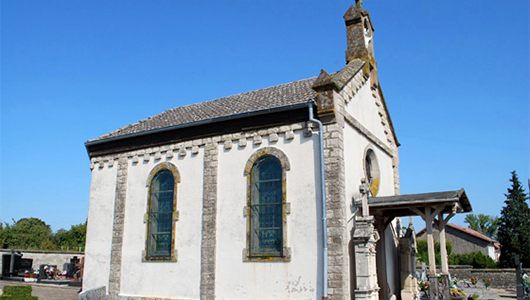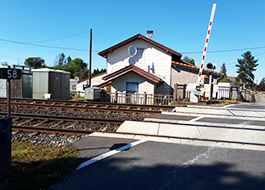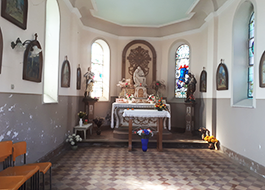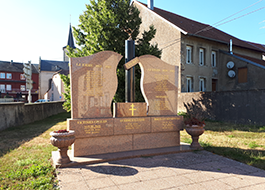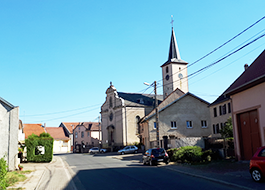Berthelming
Durée visite : 40 minutes
Moyen : Pédestre
Des vestiges romains et mérovingiens attestent d’une ancienne occupation. Le village appartenait à la collégiale Saint-Sauveur de Metz. La guerre de Trente Ans sema ici aussi ses destructions. Au XIXe siècle, la commune compta parmi ses habitants l’érudit Arthur Benoît. Membre de plusieurs sociétés savantes, il explora l’histoire de la Lorraine. Il publia de nombreux articles dans le bulletin de la Société Philomatique Vosgienne. Il traita aussi bien de Bébé, bouffon du roi Stanislas, que de l’accouchement à Saint-Dié. Une étrange association d’idées.
Roman and Merovingian remains attest to an ancient occupation. The village belonged to the collegiate Saint-Sauveur de Metz. The Thirty Years’ War also sowed its destruction here. In the 19th century, the town included the scholar Arthur Benedict among its inhabitants. A member of several learned societies, he explored the history of Lorraine. He published numerous articles in the newsletter of the Vosgienne Philomatic Society. He dealt with both Baby, King Stanislas’ jester, and the birth at Saint-Dié. A strange combination of ideas.
Römische und merowingische Überreste zeugen von einer alten Besetzung. Das Dorf gehörte der Stiftskirche Saint-Sauveur de Metz. Der Dreißigjährige Krieg zerstörerte auch hier. Im 19. Jahrhundert zählte die Gemeinde zu ihren Bewohnern den Gelehrten Arthur Benoît. Als Mitglied mehrerer wissenschaftlicher Gesellschaften erforschte er die Geschichte Lothringens. Er veröffentlichte zahlreiche Artikel im Bulletin der Philologen Gesellschaft. Er bezeichnete sowohl Das Baby, den Clown von König Stanislaus, als auch die Geburt in Saint-Dié. Eine seltsame Verbindung von Ideen.

D’azur à la fasce ondée abaissée d’argent sommée d’un col de cygne du même.
Rappel des armes des Fénétrange-Schwanhals (- col de cygne -). anciens seigneurs de Berthelming. La fasce est ondée pour évoquer la Sarre et son gué qui sont à l’origine de l’agglomération.
From azure to the wavy fasce lowered with silver summoned from a swan collar of the same.
Recall of the weapons of the Foreign-Schwanhals (- swan collar -). former lords of Berthelming. The fasce is undated to evoke the Saarland and its ford which are the origin of the agglomeration.
Von azurblau bis zur silbernen Faszene, die von einem Schwanenkragen des selben aufgesucht wird.
Rückruf der Waffen der Fénétrange-Schwanhals (- Schwanenhals -). Ehemalige Herren von Berthelming. Die Faszen sind für das Saarland und seine Furt, die den Ballungsraum ins Leben gerufen haben, unumsehbar.

Les habitants et les habitantes de Berthelming s’appellent les Berthelmingeois et les Berthelmingeoises.
The inhabitants of Berthelming are called the Berthelmingeois and the Berthelmingeoises.
Die Einwohner und Bewohnerinnen von Berthelming heißen die Berthelmingeois und die Berthelmingeoises.
Les points de visites
.
La gare est située sur la ligne Réding-Metz. En 1872, la Direction impériale des chemins de fer d’Alsace-Lorraine, allemande, ouvre la ligne Sarrebourg-Sarreguemines, puis celle de Bethelming à Rémilly. En 1919, ces infrastructures passent sous contrôle français. En 1938, l’Administration des chemins de fer d’Alsace et de Lorraine rejoint la nouvelle SNCF. Un dépôt de locomotives existait prés de la gare. En 2014, la fréquentation annuelle de la gare est de 19 411 voyageurs.
The station is located on the Réding-Metz line. In 1872, the Imperial Directorate of Railways of Alsace-Lorraine, German, opened the Sarrebourg-Sarreguemines line, then that from Bethelming to Rémilly. In 1919, these infrastructures came under French control. In 1938, the Administration of the Alsace and Lorraine railways joined the new SNCF. A locomotive depot existed near the station. In 2014, the station’s annual attendance was 19,411 travelers.
Der Bahnhof befindet sich auf der Linie Réding-Metz. Im Jahr 1872 eröffnete die kaiserliche Direktion der Eisenbahnen von Elsass-Lothringen, deutschlandisch, die Linie Saarburg-Sarreguemines und dann die Von Bethelming in Rémilly. Im Jahr 1919 wurde diese Infrastruktur unter französische Kontrolle. 1938 schloss sich die Eisenbahnverwaltung von Elsass und Lothringen der neuen SNCF an. Ein Lokomotivlager gab es in der Nähe des Bahnhofs. Im Jahr 2014 beträgt die jährliche Besucherzahl des Bahnhofs 19 411 Fahrgäste.
.
.
La chapelle fut édifiée lors d’un agrandissement du cimetière à la fin du XIXe siècle. Elle fut bénie en 1902 par l’abbé Zwickel, curé de Berthelming. La date figure au fronton de l’entrée, avec les initiales grecques de Jésus-Christ. Deux tombes de prêtres encadrent l’accès. Zwickel entreprit cette construction pour remplacer l’ancienne chapelle, datant d’avant la Révolution. L’autel est de la première moitié du XVIIIe siècle. Il provient de l’ancien bâtiment.
The chapel was built during an expansion of the cemetery at the end of the 19th century. She was blessed in 1902 by Father Zwickel, parish priest of Berthelming. The date appears on the pediment of the entrance, with the Greek initials of Jesus Christ. Two tombs of priests frame the access. Zwickel undertook this construction to replace the old chapel, dating from before the Revolution. The altar is from the first half of the 18th century. It comes from the old building.
Die Kapelle wurde bei einer Erweiterung des Friedhofs Ende des 19. Jahrhunderts erbaut. Sie wurde 1902 von Pfarrer Zwickel von Berthelming gesegnet. Das Datum steht am Giebel des Eingangs, mit den griechischen Initialen von Jesus Christus. Zwei Priestergräber umrahmen den Zugang. Zwickel unternahm diese Konstruktion als Ersatz für die alte Kapelle aus der Zeit vor der Revolution. Der Altar ist aus der ersten Hälfte des achtzehnten Jahrhunderts. Es stammt aus dem alten Gebäude.
.
Cette stèle est dédiée aux enfants de la commune, morts dans des conflits du XXe siècle. Apparus après la guerre de 1870-1871, ces monuments ont été élevés majoritairement à la suite de la guerre de 1914-1918. Les noms des » morts pour la France » des conflits postérieurs y étant alors simplement ajoutés. De nos jours, des monuments aux morts sont encore édifiés. L’expression » morts pour la France » est de mise, sauf dans les départements d’Alsace et de Moselle où, pour des motifs historiques, cette notion est remplacée pour la guerre de 1914-1918 par celle de » morts à la guerre « .
This stele is dedicated to the children of the commune, who died in conflicts of the twentieth century. Appearing after the war of 1870-1871, these monuments were raised mainly as a result of the 1914-1918 war. The names of the « dead for France » of the later conflicts were then simply added. Today, monuments to the dead are still being built. The term « dead for France » is used, except in the departments of Alsace and Moselle where, for historical reasons, this concept is replaced for the 1914-1918 war by that of « death at war ».
Diese Stele ist den Kindern der Gemeinde gewidmet, die in den Konflikten des 20. Jahrhunderts gestorben sind. Entstanden nach dem Krieg von 1870-1871, wurden diese Denkmäler überwiegend nach dem Krieg von 1914-1918 erhöht. Die Namen der « Toten für Frankreich » der hinteren Konflikte werden dann einfach hinzugefügt. Heute werden immer noch Denkmäler für die Toten errichtet. Der Begriff « für Frankreich gestorben » ist angebracht, außer in den Departements Elsass und Moselle, wo dieser Begriff aus historischen Gründen für den Krieg von 1914-1918 durch den Begriff « Im Krieg gefallen » ersetzt wird.
.
Cette église date de 1776. Elle fut transformée en style baroque en 1906. D’où vient son nom ?
Selon la tradition, la Vraie Croix fut découverte en 326 par sainte Hélène, mère de l’empereur Constantin le Grand, lors d’un pèlerinage qu’elle fit à Jérusalem. Par ordre d’Hélène et de Constantin, l’église du Saint-Sépulcre fut édifiée sur le lieu de la découverte. L’église, conservant une portion de la Croix , fut consacrée neuf ans plus tard. En 614, cette relique fut volée et emportée par les Perses. Reconquise en 618 par l’empereur byzantin Héraclius, elle fut d’abord déposée à Constantinople puis réexpédiée plus tard à Jérusalem. La date de la fête commémore la consécration de l’église du Saint-Sépulcre en 335. Ce fut alors une fête de deux jours. L’église fut consacrée le 13 septembre. Le 14 septembre, la relique fut présentée à l’adoration des fidèles. C’est désormais la date de la fête. Dans le rite catholique romain, le clergé porte des habits sacerdotaux de couleur rouge ce jour-là. Il en est de même dans les Églises anglicanes. Vêpres, jeûne et feux de joie sont pratiqués chez les orthodoxes.
This church dates back to 1776. It was transformed into a Baroque style in 1906. Where does his name come from?
According to tradition, the True Cross was discovered in 326 by St Helena, mother of Emperor Constantine the Great, during a pilgrimage she made to Jerusalem. By order of Helena and Constantine, the Church of the Holy Sepulchre was built at the site of the discovery. The church, retaining a portion of the Cross, was consecrated nine years later. In 614, this relic was stolen and taken away by the Persians. Reconquered in 618 by the Byzantine emperor Heraclius, it was first deposited in Constantinople and later re-shipped to Jerusalem. The date of the feast commemorates the consecration of the Church of the Holy Sepulchre in 335. It was then a two-day party. The church was consecrated on September 13. On September 14, the relic was presented to the worship of the faithful. It is now the date of the party. In the Roman Catholic rite, the clergy wears red priestly robes that day. The same is true in the Anglican Churches. Vespers, fasting and bonfires are practiced among the Orthodox.
Diese Kirche stammt aus dem Jahr 1776. Sie wurde 1906 in einen Barockstil verwandelt. Woher kommt sein Name?
Traditionell wurde das Wahre Kreuz 326 von der hl. Helena, der Mutter des Kaisers Konstantin dem Großen, auf einer Pilgerreise nach Jerusalem entdeckt. Im Auftrag von Helena und Konstantin wurde die Grabeskirche am Ort der Entdeckung errichtet. Die Kirche, die einen Teil des Kreuzes bewahrte, wurde neun Jahre später geweiht. 614 wurde diese Reliquie gestohlen und von den Persern mitgenommen. 618 vom byzantinischen Kaiser Herakus zurückerobert, wurde sie zunächst in Konstantinopel abgesetzt und später nach Jerusalem zurückgeschickt. Das Datum des Festes erinnert an die Weihe der Grabeskirche im Jahr 335. Es war dann ein zweitägiges Fest. Die Kirche wurde am 13. September geweiht. Am 14. September wurde die Reliquie der Anbetung der Gläubigen vorgestellt. Das ist jetzt der Tag der Party. Im römisch-katholischen Ritus trägt der Klerus an diesem Tag priesterliche Kleidung in roter Farbe. Dasselbe gilt für die anglikanischen Kirchen. Vesper, Fasten und Freudenfeuer werden bei den Orthodoxen geübt.

